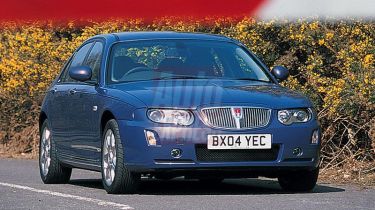Rover 75
The last time Rover launched an all-new mainstream model designed and engineered entirely by its own employees was in 1995, with the 200.
The 75 has long been our favourite Rover, and with a fresh nose it now looks even better. However, competitors have developed faster and with greater effect, so Rover is playing catch-up. The car is still a fine all-rounder, but Honda's Accord is one of a number of rivals that is cheaper and has a newer platform. We think buyers will get better value for money elsewhere.
The last time Rover launched an all-new mainstream model designed and engineered entirely by its own employees was in 1995, with the 200. Sure, we've had the mad MG SV and the TATA Indica-based CityRover, plus a number of facelifted and revised models, but where are the new cars based on cutting-edge platforms?
There's no sign of any yet, but to keep buyers interested in the current range, Rover has restyled its strongest model, the 75. Will that be enough to compete with ever-improving rivals?
Originally developed under BMW's watchful eye, the 75 has always had an elegant, sweeping shape that perfectly illustrates the suave image marketing bosses would like every Rover to have. While the MG version of the 75 - the ZT - is all about muscle and performance, the Rover has a more refined appearance, and designers have tried to emphasise that with this facelift.
The majority of the changes come at the front end, where the twin headlamps have been replaced by two one-piece units. It doesn't look that attractive at first, but the style grows on you, with a new bumper and pleasantly shaped indicator lenses as well as the lights.
Elsewhere, very little has changed, and while the design won't appeal to younger buyers, it does have a certain elegance. Other visual modifications include Rover's updated badge, which sits on a larger grille, while new alloys also set the revised 75 apart from its predecessor. At the rear, the bumper is reshaped, and the chrome badge doubles up as a boot release handle.
Move inside and the changes are less distinctive. In Contemporary trim, the dash is finished in stylish black wood, and there are new designs for the fabric on all but the most luxurious models, which get leather as standard. The rear seat squabs have also been resculpted, making the cabin feel more spacious. Wherever you sit in the 75, you're now sure to be comfortable.
Generally, there are two types of facelift: a visual makeover, or a more significant reworking, often involving re-engineered suspension and mechanicals. Unfortunately, the 75's revisions seem to fall into the former category.
While the stylists have been busy, the engineers have only found time to work on the steering, which is intended to be more responsive. On a challenging A-road, the 75 handles well, as it always has. Drivers will be hard-pressed to notice the steering modifications, but there's plenty of feel and the chassis is still up to the standards of many newer rivals. Unlike the sporty ZT, the 75 is set up to give a comfortable ride, and even on rough roads the Rover is impressive.
Our car featured the 148bhp 1.8-litre turbo engine, which turns out to be this 75's weak link. The four-cylinder K Series unit is coarse when revved, and the 3,000rpm drone at 70mph quickly becomes irritating. Fitted with a five-speed manual box, the 1.8 T covers 0-60mph in 9.1 seconds, and returns 35.3mpg. Normally aspirated rivals offer similar performance, but more refinement.
And it's when you consider the opposition that the 75 stops seeming like a sensible choice. There's no denying that the Rover is well equipped, with the standard Contemporary at £20,395. But add the cost of our car's optional kit - including the attractive pearlescent paint, 17-inch alloys and electric rear blind - and that balloons to £23,825. Newer rivals are not only superior in terms of their driving experience and packaging, they are cheaper, too! Rover can't go on re-skinning existing models forever...






